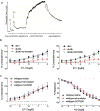Statins improve endothelial function via suppression of epigenetic-driven EndMT
- PMID: 37693816
- PMCID: PMC10489108
- DOI: 10.1038/s44161-023-00267-1
Statins improve endothelial function via suppression of epigenetic-driven EndMT
Abstract
The pleiotropic benefits of statins in cardiovascular diseases that are independent of their lipid-lowering effects have been well documented, but the underlying mechanisms remain elusive. Here we show that simvastatin significantly improves human induced pluripotent stem cell-derived endothelial cell functions in both baseline and diabetic conditions by reducing chromatin accessibility at transcriptional enhanced associate domain elements and ultimately at endothelial-to-mesenchymal transition (EndMT)-regulating genes in a yes-associated protein (YAP)-dependent manner. Inhibition of geranylgeranyltransferase (GGTase) I, a mevalonate pathway intermediate, repressed YAP nuclear translocation and YAP activity via RhoA signaling antagonism. We further identified a previously undescribed SOX9 enhancer downstream of statin-YAP signaling that promotes the EndMT process. Thus, inhibition of any component of the GGTase-RhoA-YAP-SRY box transcription factor 9 (SOX9) signaling axis was shown to rescue EndMT-associated endothelial dysfunction both in vitro and in vivo, especially under diabetic conditions. Overall, our study reveals an epigenetic modulatory role for simvastatin in repressing EndMT to confer protection against endothelial dysfunction.
Figures

















Comment in
-
Simvastatin protects against endothelial dysfunction via epigenetic mechanisms.Nat Rev Cardiol. 2023 Jul;20(7):442. doi: 10.1038/s41569-023-00893-z. Nat Rev Cardiol. 2023. PMID: 37237147 No abstract available.
References
-
- Chou R, Dana T, Blazina I, Daeges M & Jeanne TL Statins for prevention of cardiovascular disease in adults: evidence report and systematic review for the US Preventive Services Task Force. JAMA 316, 2008–2024 (2016). - PubMed
-
- Sen-Banerjee S et al. Kruppel-like factor 2 as a novel mediator of statin effects in endothelial cells. Circulation 112, 720–726 (2005). - PubMed
-
- Laufs U, La Fata V, Plutzky J & Liao JK Upregulation of endothelial nitric oxide synthase by HMG CoA reductase inhibitors. Circulation 97, 1129–1135 (1998). - PubMed
Grants and funding
- R01 HL113006/HL/NHLBI NIH HHS/United States
- R01 HL163680/HL/NHLBI NIH HHS/United States
- R01 HL161002/HL/NHLBI NIH HHS/United States
- R01 HL155282/HL/NHLBI NIH HHS/United States
- R35 GM119522/GM/NIGMS NIH HHS/United States
- R01 HL141371/HL/NHLBI NIH HHS/United States
- R01 HL150693/HL/NHLBI NIH HHS/United States
- R01 HL126527/HL/NHLBI NIH HHS/United States
- R01 HL130020/HL/NHLBI NIH HHS/United States
- P01 HL141084/HL/NHLBI NIH HHS/United States
- R01 HL145676/HL/NHLBI NIH HHS/United States
- R01 HL141851/HL/NHLBI NIH HHS/United States
- R01 HL158641/HL/NHLBI NIH HHS/United States
LinkOut - more resources
Full Text Sources
Research Materials
